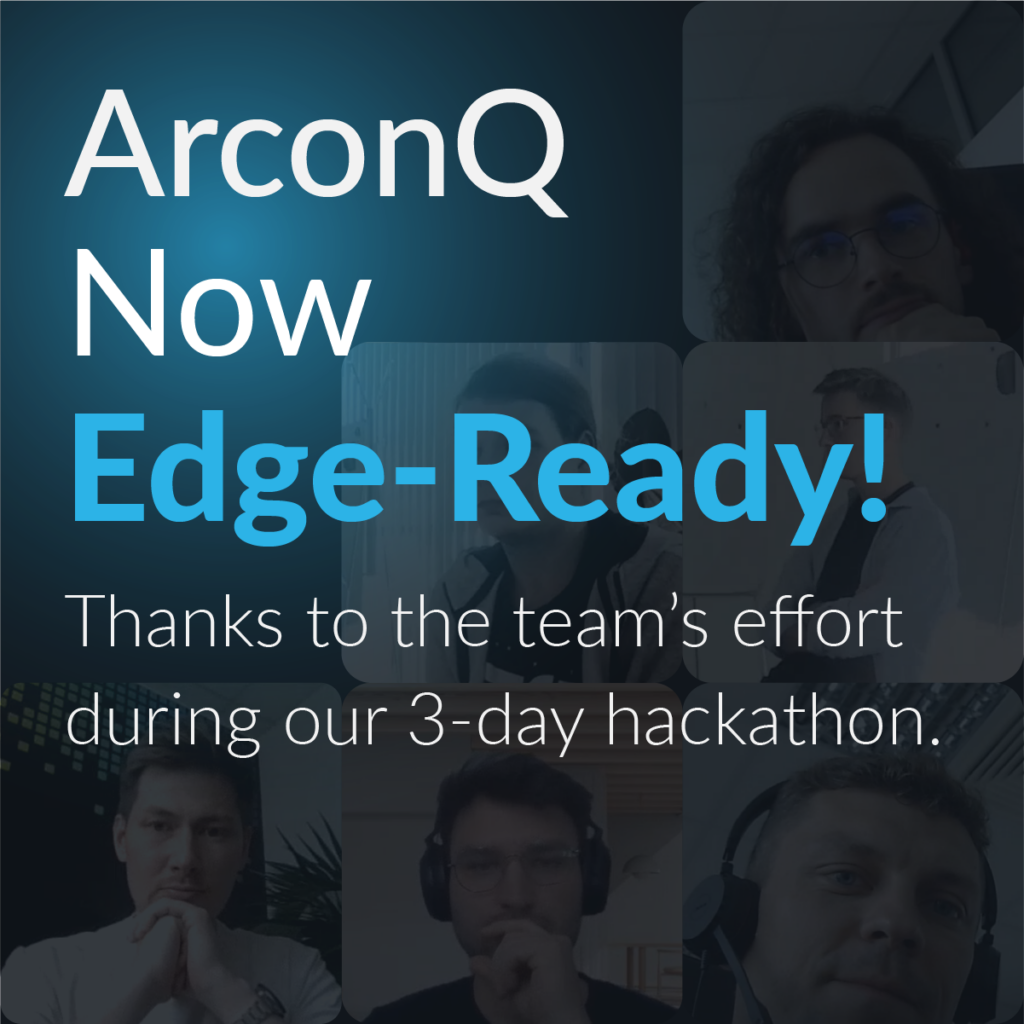From September 4th to 6th 2024, the ArconQ team gathered at the Macrix office in Poznań for a 3-day hackathon. They split into two teams, with one goal in mind:
Enable ArconQ applications to run seamlessly outside of the cloud environment, directly on external devices. At the same time, keep all built-in ArconQ’s features (App repository, logging, messaging, etc.) in place.

The task was challenging, but the rules were simple
Two teams – Stanisław Boboryk & Bartłomiej Zając (Team 1) and Marcin Ptak, Mateusz Michno & Kacper Pocheć (Team 2) – were formed. Each team had its own dedicated workspace, but shared the same task definition, resources, and access to drinks and snacks. Under the guidance of Rustam Ashurov, Head of R&D at Macrix, both teams worked in a fair and competitive environment, with clear boundaries for collaboration. While teams could seek help from experts and Macrix colleagues, collaboration between competing teams was limited.
The real-world challenge: factory automation meets cloud limitations
Picture this: a factory buzzing with activity, with machinery, sensors, and PLCs generating a constant stream of data. This data is processed in the cloud by ArconQ, delivering real-time insights and control. However, what happens when the factory’s network is unstable, or when decisions need to be made locally in real-time, without relying on the cloud? Sometimes, there must be a physical connection to or from a device to retrieve its readings or steer it directly, adding another layer of complexity when relying solely on cloud-based solutions.
In such cases, factory-side applications had to be built separately and connected to the cloud via REST APIs. These apps lacked ArconQ’s rich feature set – like centralized logs, messaging, scheduling, and monitoring – and were invisible within the ArconQ platform itself.
The hackathon mission: bringing cloud power to the factory floor
The hackathon’s objective was crystal clear:
Enable applications built for ArconQ’s cloud environment to run directly on edge devices, providing seamless integration with local factory sensors and machinery. These edge applications needed to be fully visible within the ArconQ platform, allowing for features like monitoring, logging, and deployment – all in real-time.
Bonus points were awarded for going the extra mile, such as managing and monitoring the devices, handling app restarts after failures, and running multiple apps on a single device simultaneously.
The solution: real-time edge integration with ArconQ
After over 2 days of intense coding, both teams independently designed similar architectures to solve the challenge. The solutions involved creating an additional service (named by two teams respectively: ArconQ Demon and ArconQ Controller) that enabled the functionality of ArconQ applications on external devices while maintaining essential physical connections to these devices for real-time control and data retrieval.
At the end of the Hackathon, the teams showcased their progress by demonstrating real-world examples, such as connecting a camera, a button and LED diode to a Raspberry Pi, allowing for real-time data transfer and interaction with ArconQ. Security was also a key focus, with both teams implementing SSL encryption and client authorization to ensure safe communication between the cloud and the edge devices.
The result: a prototype for the future
By the end of the hackathon, both teams had developed working prototypes that lay the groundwork for a future where edge devices can fully integrate with the ArconQ ecosystem. These prototypes allow for real-time deployment, increased resilience, and a fully interactive user interface, ensuring that factories can keep running smoothly – even when the network is unreliable.
The hackathon was a success, showcasing how innovation and teamwork can overcome real-world challenges. This breakthrough brings ArconQ one step closer to providing a truly connected, resilient system for industrial automation.
What do participants think about the initiative?
“I think the initiative was fantastic. This is really something else. I had the opportunity to work a lot with things that I just didn’t have the opportunity to do on a daily basis. It was a very intense teamwork. And you can’t hide the fact that it was a bit stressful to bring it all together, because there was a pressure of time, because it was only three days. But the initiative is great. I’m looking forward to the second hackathon. It’s also great that it’s not something that will be just discarded, it’s code that, in some way, might end up in our archive.”
Marcin Ptak, senior developer
“I know it’s not a completely finished solution yet, but after just 2.5 days of coding, it’s clear that the ability to integrate external devices isn’t a limitation at all. We can easily connect external devices, like sensors and PLCs, and make them a seamless part of the applications running in ArconQ, even outside the cloud environment.”
Stanisław Boboryk, senior developer
“I think we all want to sleep very much after these three days. But I think it was very, very inspiring. It was a fight against everything, against deadlines, against the problems that we solved. I had a chance to participate in two teams, well, you could see that each team had a challenge, and in general, it went very well. And the subject of the next hackathon? I already have, more or less, the next topic. Of course, it won’t be in the next week, and maybe not in a month, because we have to have some kind of interval, so that there is always fresh air.”
Rustam Ashurov, Head of R&D

